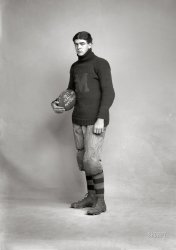
MAY CONTAIN NUTS

Search Shorpy
SHORPY ART

Framed or unframed, desk size to sofa size, printed by us in Arizona and Alabama since 2007. Explore now.
Join and Share
Ad-Free Shorpy
Shorpy is funded by you. Patreon contributors get an ad-free experience.
Learn more.

Recent comments
- Baldwin 62303
- Baldwin VO-1000
- Cold
- No expense spared
- Tough Guys
- Lost in Toyland
- And without gloves
- If I were a blindfolded time traveler
- Smoke Consumer Also Cooks
- Oh that stove!
- Possibly still there?
- What?!?
- $100 Reward
- Freeze Frame
- Texas Flyer wanted
- Just a Year Too Soon
- WWII -- Replacing men with women at the railroad crossing.
- Yes, Icing
- You kids drive me nuts!
- NOT An Easy Job
- I wonder
- Just add window boxes
- Icing Platform?
- Indiana Harbor Belt abides
- Freezing haze
- Corrections (for those who care)
- C&NW at Nelson
- Fallen Flags
- A dangerous job made worse
- Water Stop
Member Photos
The Shorpy
Print Emporium
Print Emporium
Search Shorpy
Search results -- 30 results per page
- Ladies vs. Tomboys: 1955
- April 9, 1955. Atlanta, Georgia. "Softball or ballet? Linda McConkey, of the Lorelei Ladies ... game; and Jerrie Rainey, playing third base for the Atlanta Tomboys, as she jumps for the ball." Wide World photo. View full ... retired her jersey.
(The Gallery, Atlanta, News Photo Archive, Sports) ... Posted by Dave - 06/22/2020 - 2:52pm -
![Ladies vs. Tomboys: 1955 April 9, 1955. Atlanta, Georgia. "Softball or ballet? Linda McConkey, of the Lorelei Ladies softball team, diving for third base during an exhibition game; and Jerrie Rainey, playing third base for the Atlanta Tomboys, as she jumps for the ball." Wide World photo. View full size.
Safe at thirdGreat form, the two of them, but no way is Jerrie getting Linda out.
Still ThereNot Linda or Lorelei, but the softball fields at Piedmont Park, near the soccer fields and beach volleyball courts, all surrounded by an 800-meter granite dust running track. A mighty blast can send the ball rolling near the steps shown in the pic. In the 1890s the park also hosted the first UGA-Auburn college football games.
Linda may be safeBut Jerrie's got better legs and quite possibly a cuter outfit.
Even if a spike comes down on a handWe can all be sure that there will be No Crying.
'Tomboy' anyone? no one?I was curious about the term "tomboy," which I thought must be banished to the dustbin of embarrassing stereotypes. Not exactly, though you can find plenty of calls to discard it (including by the Girl Scouts). At the same time, it has been appropriated by advertisers and (concept and imagery at least) by radical gender-benders.
It's an old term, originally referring to a brash male youth. It was also sometimes attached to an immodest woman. By the 17th century it had the familiar reference to a "boyish" girl.
In the 19th and 20th centuries, tomboys were everywhere in culture and especially literature. There are academic studies.
When this photo of the softball players was taken in 1955, Harper Lee was creating Scout (birth name Jean Louise Finch).
Super GirlsIt didn't even dawn on me they were playing softball when I first saw this photo. As a lifelong Superman family fan, I saw one Supergirl coming in for a landing (great form!) while another was taking off straight up (unusual but sometimes done).
My Photography Knowledge is slimIn 1955; what shutter speed would the photographer use to catch this amazing shot?
[The same as you'd use today. - Dave]
That’s my GrandmotherLinda was definitely safe; I can’t remember all of the details, but I can get them and share them with y’all if you like, because that’s my Nanna diving into third base. She was an amazing athlete and only recently slowed down in the past ten years or so. She’ll be 83 in September and keeps a copy of this photo in a book at my parents’ house. She’s absolutely one of the most incredible humans I’ve ever known.
And as for the legs, that’s debatable. See, Nanna was not only known for her athletic prowess, but her beauty ... and those legs. Boys would come from other schools to watch her legs as she ran up and down the court at her high school basketball games, where they eventually retired her jersey.
(The Gallery, Atlanta, News Photo Archive, Sports)](https://www.shorpy.com/files/images/SHORPY-18795u.thumbnail.jpg)
- Southern Terminal: 1941
- ... August 1941. "Trains in the Southern Railway terminal in Atlanta, Georgia." Medium format nitrate negative by John Collier. View full ... that the photo was taken at Terminal Station in downtown Atlanta. Here is a picture of the Old (1918-1970) Terminal.
Arches and ... Posted by Dave - 04/17/2016 - 8:19pm -
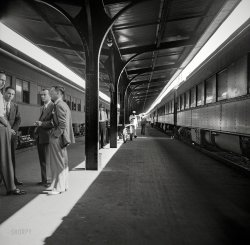
- Bay Windows: 1899
- ... Man on the porch of his house in Georgia, probably near Atlanta. 1899 or 1900. View full size. Gelatin silver print from the ... off but its shadow is not. What gives?
(The Gallery, Atlanta) ... Posted by Dave - 07/22/2012 - 2:44pm -
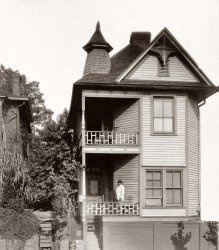
- Rail Disaster: 1933
- ... Railroad, on the Southern Railway from Washington to Atlanta, on the Atlanta & West Point / Western Railway of Alabama from Atlanta to ... Posted by Dave - 07/02/2014 - 8:18pm -
![Rail Disaster: 1933
GRAVE OF MUD
WASHINGTON, Aug. 25, 1933 -- While thousands worked to overcome the havoc wreaked by the storm in the Capital, 300 trainmen struggled with the wreck of the Crescent Limited. The crack extra-fare express was hurtled yesterday from the tracks of the Pennsylvania Railroad when flood waters undermined the central abutment of the bridge over the Eastern Branch [Anacostia River], just inside the District. All day and all night the crews of railroad men worked, first with acetylene torches to clear debris from the approaches to the bridge, and then with three cranes to lift aside the wrecked cars. Late in the evening a derrick lifting the crushed engine from a grave of mud uncovered the body of the engineer, Arthur H. Bryde, of Washington. The body of J.H. Faye, the fireman, of Havre de Grace, was recovered earlier in the day. It had been ground into the mud of the embankment by a coach.
August 1933. Washington, D.C. "Crescent Limited train wreck." Another look at this wreck. Harris & Ewing Collection glass negative. View full size.
Men dead; locomotive saved.It's a K-4 Pacific type, seen many times on this site. Don't know what number it is, but it was definitely rebuilt. The first K-4 to be scrapped was #8309 in 1938, after a different wreck which occurred in Pittsburg when it plummeted off a high fill and then dropped another fifty feet over a concrete retaining wall into one of the city streets. The leading truck of the K-4 seen above is sunk in the mud dead-center of the photo.
Wrong truckOn a railroad, a truck is the assembly of wheels, springs, brakes, and centering devices which ride on the rails, supporting and guiding the car or locomotive it supports.
The engine is unmistakably, as pointed out, a Pennsylvania Railroad K-4 class 4-6-2 Pacific.
But, neither of the two trucks visible near the center of the photo came from that engine. K-4 pilot trucks were inside bearing. Perhaps, these were from under the tender, or from one of the passenger cars.
Re: Wrong TruckI stand corrected; how I missed them being outside bearing I have no idea. They probably are from beneath the tender, as the lead truck there is missing. Doubt they're from a car, as those appear to be all heavyweight equipment with six-wheel trucks.
LocomotivesWasn't the "Crescent" usually pulled by a Southern RR locomotive?
PRRA Southern 4-6-2 would pull it south of Washington. Guess this wreck must have been at the PRR bridge at 38.917N 76.9435W, where a PRR engine would pull the train.
Re: Re: Wrong truckThey are definitely Tender trucks. PRR Class 2D-T4 to be precise.
Crescent Question"Wasn't the "Crescent" usually pulled by a Southern RR locomotive?"
The Crescent Limited operated from New York to Washington on the Pennsylvania Railroad, on the Southern Railway from Washington to Atlanta, on the Atlanta & West Point / Western Railway of Alabama from Atlanta to Montgomery, AL, and on the Louisville & Nashville from Montgomery to New Orleans.
This particular train would have originated in Penn Station behind an electric locomotive (probably a PRR P5). PRR steam replaced the electric in Wilmington, DE; a Southern Railway Ps4 would take over in Washington (there may also have been an engine swap midway to Atlanta in Salisbury, NC). In Atlanta, WofA 190 or A&WP 290 (which were purchased specifically to haul this train) would take over, and an L&N locomotive would the train on the final leg of the journey.
(The Gallery, D.C., Harris + Ewing, Railroads)](https://www.shorpy.com/files/images/SHORPY-37162a.thumbnail.jpg)
- Lenny and Edna: 1924
- ... Dad was off minding the boats.
Edna Does D.C. Atlanta Constitution, 11 July 1924
New Cabinet Daughter
Lands in ... Posted by Dave - 08/13/2012 - 6:08pm -
![Lenny and Edna: 1924 June 3, 1924. "Leonard and Edna Wilbur," children of Navy Secretary Curtis Wilbur. National Photo Company Collection glass negative. View full size.
Edna & OnaFrom the Lima (Ohio) News, April 9, 1928:
Rescued by forest rangers from a narrow ledge 2,000 feet high, where darkness had trapped her and her girl companion during a trip thru Yosemite valley, Miss Edna May Wilbur, daughter of Secretary of the Navy Curtis D. Wilbur, was home here none the worse for her thrilling experience. Miss Wilbur went to the park with a party of friends. She and Miss Ona E. Ring attempted late Saturday to descend the snow-covered trail from Glacier point to the floor of the valley. Caught by darkness, they lost the trail and presently found themselves on the narrow ledge, whence they feared to attempt further progress. With a biting mountain wind tugging at their clothing, the girls huddled against the face of the cliff and called for help. Tourists in the valley, 2,000 feet below, heard their cries, and notified the forest rangers. Five men reached the girls shortly before midnight, and strenuous efforts succeeded in hauling them up to the trail with ropes.
[Thrilling! I think this was an episode of "Leave It to Beaver." - Dave]
Tats or Vacs?Those circular things on her arms. Can I assume that they were vaccination scars? She certainly has a modern attitude or so it seems.
[That's mold on the emulsion. - Dave]
Yes, DaveYes, the episode wherein the Beav climbs into a teacup and can't climb out and is rescued by the fire department. Amazing how daring Miss Wilbur was - that explains the dress.
[Not quite. I was thinking of the episode where Beaver and Gilbert go camping, get stuck on a ledge and are rescued by park rangers. - Dave]
Still waters run deepMiss Edna has a certain sly gleam in her eye. I'll bet she danced a few Charlestons in her time while Dad was off minding the boats.
Edna Does D.C.Atlanta Constitution, 11 July 1924
New Cabinet Daughter
Lands in Capital
And Looks it Over
Washington's newest cabinet daughter has been spending her first few days in the capital just like anybody's daughter here on an excursion trip -sightseeing.
Miss Edna Wilbur, whose father is secretary of the navy, arrived last Thursday from California. She came through the Panama canal with her brother, Leonard Wilbur, and then up the Chesapeake bay and the Potomac, from Hampton Roads, on the neat little yacht Sylph, which is at her father's disposal as boss of the navy.
...
Miss Wilbur is Washington's third cabinet daughter of marriageable or debutante age. Both the other two aren't braving hot weather here.
...
Miss Wilbur has another cabinet distinction besides braving Washington heat. She's the only daughter of a cabinet member who knows how it feels to spend money earned by herself.
The daughter of the navy secretary is a California high school teacher and she didn't give up her job just because her father is a member of President Coolidge's cabinet ...
Miss Wilbur is a tall girl, with much pale yellow hair and a fair skin. Not pretty, but attractive looking. And not the debutante or flapper type.
She is quiet and self-possessed. She has the voice and manner of a successful teacher.
And --no, her hair is not bobbed!
A Boston Globe article from April 13, 1924 says Edna graduated from Stanford with a degree in French. She was teaching at Chico High School.
Leonard or Lyman, perhaps Paul?I've been doing some research on Curtis Wilbur and all the sites list his children as Edna, Paul and Lyman. Perhaps Leonard was a nickname or is this a typo?
[Leonard Wilbur's name makes dozens of appearances in the historical archives of various newspapers. See the next comment up. - Dave]
Dr. Leonard Wilbur's mission Young Leonard would lead an inspiring, but all too short, life. After graduating from medical school at Stanford (where his uncle had been a president) he and his wife embarked upon a mission to Northern China, starting a hospital in the province now known as Shanxi. First the communist insurgents invaded (and the Wilburs were reported missing) in 1936. They resurfaced, but in late 1937 the Japanese invaded Shanxi (and the Wilburs were again reported missing but resurfaced). On Easter in 1940, during the Japanese occupation, Leonard died of typhus. He was only 33. His wife survived, and became one of the heirs to father-in-law Curtis Wilbur's inheritence when he died in 1954.
Sorry, Miss Edna.I guess you weren't the flapper I took you to be. The sly gleam must have been that look you gave your students to let them know you meant business.
Wilbur childrenCurtis D Wilbur had 5 children...
1. Ralph 3/18/1903 - 3/24/1906 age ~3
2. Leonard 3/2/1907 - 3/24/1940 age 33.
3. Edna was 25 in this photo, and Leonard 17.
From Pathways: A Story of Trails and Men (1968) by John W. Bingaman--
The Ledge Trail: "In 1871, James M. Hutchings had been guiding parties of hikers to Glacier Point over a most hazardous trail, which he had blazed up the Ledge and through the chimney and which climbed 3,200 feet in approximately one and a half miles to Glacier Point. This was the Ledge Trail.
In 1918, it was repaired by the Park Service. It was a dangerous climb because it was partly built of solid rock, and extremely steep, much like a staircase. Rock slides occurred frequently causing accidents to climbers. Only up-travel was permitted by the park regulations in later years. After several major floods, rock slides, injuries, and deaths to climbers the park authorities deemed it necessary to close this trail to all hikers. The Author assisted in rescue parties several times on this trail."
Edna hiked the Sierra's of California until she was 90.
4 & 5. Paul and Lyman lived until they were 100.
(The Gallery, D.C., Natl Photo)](https://www.shorpy.com/files/images/11692u.thumbnail.jpg)
- The View From Here: 1864
- ... died n this war. My grandfather saw feathers n the air n Atlanta and at age 5, found it amazing. He learned later that Sherman and ... Posted by Dave - 09/13/2011 - 2:16pm -
![The View From Here: 1864 1864. "Nashville, Tennessee. View from Capitol." Wet plate glass negative by George N. Barnard. View full size.
In Union handsIf you were Sesech, it didn't look good for you in Nashville either. When this photo was taken, Nashville was already under Union control as it was the first Confederate capital to fall to Federal troops in February 1862.
StatuesqueAn alternate view, along with a link (in the comments) to the story of the statues.
Doesn't look good.When I look north I see Grant marching to Virginia, and to the south I see Sherman marching to the sea.
Battle of Nashville Preservation Society "During the Union occupation of Nashville (1862-65), the Capitol was transformed into Fortress Andrew Johnson. The artillery located there never had to be fired in battle, but were used for drills and celebrations."
That would explain the massive timbers blocking the steps.
Men In BlackTake the clothes off the guy on the right and it would almost look like he belongs there, however I wouldn't want to see it.
Five blocks awaySit I in my office (which was used as a hospital during the Civil War)
Civil WarMy great-grandfathers died n this war. My grandfather saw feathers n the air n Atlanta and at age 5, found it amazing. He learned later that Sherman and troops were splitting all feather beds looking for hidden treasures.
[How nteresting. - Dave]
Almost existentialist. Every time I see these two remarkable photographs I think of how modern their composition is. For me, they're an inseparable pair which should be viewed sequentially, as here. (I'd have been most proud if I'd taken them).
For the period -- hardly 30+ years since the invention of photography and barely having emerged from slow poisonous daguerreotype era -- these photographs, especially the second one, are just wonderful. Composition, lighting, photographic technology, happenstance, a first rate photographer and even a ladder have all combined to make what we today would understand as iconic prizewinning photos.
The inclusion of the ladder is masterful, 'tis a mindbogglingly modern touch for 1864.
Is that George N. Barnard himself holding the statues up (I wouldn't be s bit surprised)? Does anyone know for sure?
(The Gallery, Civil War, Geo. Barnard, Nashville)](https://www.shorpy.com/files/images/02068a.thumbnail.jpg)
- Sam Cooley: 1865
- ... in the Engineer Corps), did yeoman's service around Atlanta.
-- Henry Wysham Lanier, Photographing the Civil War
... Posted by Dave - 03/25/2015 - 11:32am -
![Sam Cooley: 1865 Circa 1865. "Wagons and camera of Sam A. Cooley, U.S. photographer, Department of the South." Wet plate glass negative. View full size.
Photographing the Civil WarWe shall get some more glimpses presently of these adventurous souls in action. But, as already hinted, extraordinary as were the results of Brady's impetuous vigor, he was but one of many in the great work of picturing the war. Three-fourths of the scenes with the Army of the Potomac were made by Gardner. Thomas G. Roche was an indefatigable worker in the armies' train. Captain A. J. Russell detached as official camera-man for the War Department, obtained many invaluable pictures illustrating the military railroading and construction work of the Army of the Potomac, which were hurried straightway to Secretary Stanton at Washington. Sam A. Cooley was attached to the Tenth Army Corps, and recorded the happenings around Savannah, Fort McAllister, Jacksonville, St. Augustine, Beaufort, and Charleston during the bombardment; George M. Barnard, under the supervision of General O. M. Poe (then Captain in the Engineer Corps), did yeoman's service around Atlanta.
-- Henry Wysham Lanier, Photographing the Civil War
Wow!How many megapixels has your camera got, mister?
There's the rubI wonder how many glass plates were broken or had the emulsion rubbed off, regardless of packing, as they bounced around in the wagon. Packed in cotton or excelsior? (Was there excelsior yet?)
[I think they'd be packed in negative cases. Large plush-lined boxes with edge-slots to hold the plates. - Dave]
BureaucracyThere was a Department of the South?
Civil War DepartmentsThe Union Army effectively split the country into Military Departments covering various geographic areas: Department of the West, Department of the Pacific, Department of the Cumberland, Department of New England and so on. The various Departments were responsible the installations and armies operating within these geographic regions. The Department of the South was one of these regions. At least initially the department consisted of Union held regions of South Carolina, Georgia and Florida.
The signs on Sam Cooley's wagons would seem to indicate that he was effectively the "official" military photographer for the Department and presumably gave him much greater access than other photographers would get.
(The Gallery, Civil War, Sam Cooley)](https://www.shorpy.com/files/images/03518a.thumbnail.jpg)
- Fancy Grocery: 1935
- ... about the chimneys on the right. Is it possible that Atlanta in 1935 still had gaps where buildings were destroyed (by Sherman?) in ... possible, but then again, this was taken in Alabama, not Atlanta.
Maybe Could be the result of Sherman's lesser-known "March to ... Posted by Dave - 08/20/2012 - 1:09am -
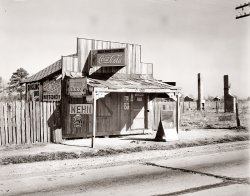
- Nitro Express: 1939
- ... office.
Chapman then robbed the First National bank of Atlanta, Texas (twice). He was captured after the second robbery and given a ... Posted by Dave - 01/14/2018 - 7:31pm -
![Nitro Express: 1939 October 1939. "Post office in the general store. Lamoille, Iowa." Let's see now. Stamps, ammo, and a case of Iten-Barmettler, please! Medium format negative by Arthur Rothstein for the Farm Security Administration. View full size.
Bullet PointsLook at that Remington poster with the boy and his Indian chief metal silhouette! I've tried to do just that, but only have luck with a punch and hammer.
Everything's up to date in LaMoilleSocial Security was so new, they needed a poster explaining that they wanted to hand out money. (My grandfather's Social Security card, which was issued around this time, had a short explanation on the back, too, and gave an address in Washington where you could write for more information. My father's card, issued in the 1950s, had a different, but still relatively friendly, explanation, of how to use it. Mine is full of dire warnings about improper use.)
You can also send mail on an AIRPLANE for only 3 cents!
Not only that, but you can send insured parcel post packages to France, Italy, and Japan, and registered parcel post packages to Germany! (Limited time offer.)
Love that kid's overallsWish I could find some like that today.
For the same reason you can't at home.Or maybe Mom has other reasons why you can't spit on the floor. In any case, the sign helpfully offers one explanation. I can think of others, if you need more reasons to refrain.
Frost Killer indeed!I'll bet 'ol man Winter didn't dare get close to that No. 218!
Real P.O.Would not be an official Post Office if it did not have that wanted poster.
Desperado: 1898-1942A thumbnail sketch of Irving Charles Chapman, seen on the Wanted poster at lower right, from Oklahombres.org:
Irving Charles Chapman was born on December 29, 1898 in Philadelphia, Mississippi. During the stock market crash in the late 1920s, he lost all of his fortune, and decided to be a criminal instead. He began a series of kidnappings and bank heists in Mississippi, Arkansas and Louisiana. He began his criminal ways with a few minor arrests in Florida and New Jersey, before embarking on a decade-long career as a gangster.
In 1932 he was sentenced to serve 9 to 14 years for a Miden, Louisiana, bank robbery. However, he and two others escaped from the Caddo Parish jail at Shreveport on December 5, 1932, by lowering themselves from their eighth-floor cell with a rope made from whatever they could find. Captured in 1934, he was wounded in a gunbattle with police and sentenced to 15 years for a bank robbery in Mississippi. He was turned over to Arkansas, where he received another 15-year term for another bank heist. He escaped from the Tucker Prison (some reports say he escaped from a Little Rock prison) on August 25, 1936, using a pistol taken from the warden's office.
Chapman then robbed the First National bank of Atlanta, Texas (twice). He was captured after the second robbery and given a 60-year prison term. He was sent to Eastham Prison Farm, the same one Clyde Barrow was once imprisoned at. He along with infamous Oklahoma bandit Pete Traxler, as well as six others, escaped on June 22, 1937. All were captured or killed except Chapman.
In 1939, he shot his way out of a police trap near his home town in Mississippi. In January 1942, he shot Patrolman Ralph McNair at Meridian and escaped. Finally, on February 22, 1942, he drove away from his residence and right into a roadblock. He was shot, and before dying told the police, "Go ahead and shoot, you bastards!"
They didn't have to, as he succumbed to his wounds. He was buried at the Sandtown Cemetery at Sandtown, Mississippi. So ended the career of this famous outlaw!
The Wanted PosterClick to enlarge.
Different country, different decadeBut kind of reminds me of may preschool days when my grandma gave us a little change in order to run down to the neighbourhood grocery shop and have a Kaiser roll filled with a whippet cookie. Yummy.
Alas, no more neighbourhood grocery stores. No more running down the street on one's own for a preschooler. And a white flour wheat product filled with foamed sugar and fat? That's just sooo nutritionally incorrect.
Sam Drucker Seal of ApprovalWhile looking a little beat down in the photo, a nice condition Eclipse/Tappen "Frost Killer" stove today at auction might go for around $2,000+. Whether ol' No. 218 is still in the mix somewhere, who knows?
WantedIRVING CHARLES CHAPMAN, for Bank Robbery
It has an ageThat Eclipse #218 "Frost Killer" stove predates 1920, the year that the Tappan family of Mansfield, Ohio, changed the name of their stove company from Eclipse to Tappan.
I'm undecided about whether the storekeeper is burning coal or wood (it could use either), but I am fairly certain that the stains below the firebox door are evidence of sitters-and-spitters-and-whittlers getting cranked up for the winter.
And the case of Iten Barmettler? It's either crackers or cookies, both of which the Iten Barmettler Biscuit Company of Omaha made for years.
They must be brothers The postmaster and the coffee grinder in this:
https://www.shorpy.com/node/22928
Sure look as if they could be brothers.
[They are the same person. -tterrace]
[In the same store. - Dave]
(The Gallery, Arthur Rothstein, Kids, Stores & Markets)](https://www.shorpy.com/files/images/SHORPY-8b19033a.thumbnail.jpg)
- Housewifery 101
- ... Wires and Gas When I first moved into my old house in Atlanta, a house built in 1910 or so, I found cloth-insulated wires for ... Posted by Dave - 08/22/2012 - 8:38pm -
![Housewifery 101 "McKinley School lab." Home economics at McKinley High School in Washington circa 1910. Harris & Ewing Collection glass negative. View full size.
Asbestos mat?Well at least they did not have guns, drugs, or knives.
Ok, I'll biteWhat are the twin chains hanging from the ceiling for?
[My guess would be damper chains. - Dave]
Oh GoodIt's comforting to see that "1 - asbestos mat" is included in the chalkboard list of kitchen must-haves!
Chains on the ceilingIf it's anything like the high school I went to the chains operate the sashes on skylights.
As far as the asbestos mat,As far as the asbestos mat, Asbestos has a bad reputation because of asbestosis, but a well made asbestos blanket is perfectly safe as long as you don't let it get frayed.
However, I think Dave's got the title wrong on this one... these young ladies aren't studying to be housewives, they're studying to be the hired help, kitchen maids or cooks, judging by how they're dressed. The room isn't even set up right to properly emulate a "normal" home of the era.
Of course, I could be wrong....
[McKinley Manual Training School was, at least in name, a vocational high school. But that doesn't mean these ladies aren't learning the domestic arts while they're in the cooking lab. The aprons, like the aprons in any lab or kitchen, are there to protect your clothes. Something tells me there weren't many white girls in circa 1910 Washington pursuing careers in domestic service. - Dave]
Combo lightsIt appears those lights are combination gas and electric- with a gas jet pointing up behind each bulb.
[They're gas fixtures that have been wired for electricity. A common practice when electricity was replacing gas for illumination. - Dave]
All right Dave, explainSo why do you think there weren't many white girls in circa 1910 Washington pursuing careers in domestic service? Seriously, do you know something I don't? From what I've read, photographs, etc, there seem to have been scads of white servants in that era. It's pretty darn common vocation for a girl of modest means, and those frilly white caps indicate a servant uniform. You don't see many housewives wearing those - strictly for the help. I'm not sure how being in Washington in 1910 would have changed that. Was there a highly localized white-domestic plague that year?
[Anything is possible. Maybe McKinley High did have a "maid training" program where you got to play dress-up. Most of the girls shown taking food-preparation instruction in photos from this era are shown wearing aprons and caps. Then as now, food preparers in an institutional setting would wear a cap or hairnet. If these girls had career aspirations that involved cooking, I think nursing or restaurant work would be the more likely choices. The McKinley course offerings as listed in the Washington Post archives are pretty general -- machine shop, carpentry, motor repair, home economics. The classroom in our photo was the "domestic science" (home economics) lab. Instruction was given in "plain and fancy cookery," invalid cookery and menu planning. - Dave]
I don't think it's jettingThe light fixture on the right has tubing coming out of what would be the jets, so I'm not sure where the flame was supposed to be. Unless... the ends were cut off and fixed with lightbulbs. But they're sorta facing downward instead of upward.
[That's a rubber hose for something like a Bunsen burner. So the gas must still be connected. - Dave]
I would have failed the classSince I really hate to cook!
Gas hoses for tabletop useScary as it seems to me, combination gas and electric chandeliers also provided convenient sources for portable gas table fixtures via rubber hoses such as the one in this photo. I've seen a 1910 photo of a gas table lamp in the parlor of Ulysses S. Grant Jr.'s house in San Diego, using just such a hose dangling down from a gascock on the chandelier overhead.
Wires and Gas When I first moved into my old house in Atlanta, a house built in 1910 or so, I found cloth-insulated wires for overhead lamps running through the gaspipes to every room ceiling. It confused me until I realized that electricity was added onto the house in the twenties. There were also the "knob and tube" ceramic insulators all over the attic. I got that overhauled quick!
(The Gallery, D.C., Education, Schools, Harris + Ewing, Kitchens etc.)](https://www.shorpy.com/files/images/15202a.thumbnail.jpg)
- Hank Aaron: 1934-2021
- ... record in sports for more than 30 years, died today in Atlanta. He was 86. -- New York Times
Arron? Really? For the ... that?
RIP I remember when he hit 714; we lived in Atlanta and although I was only 17 and living in an all-female household and ... Posted by Dave - 01/22/2021 - 1:43pm -
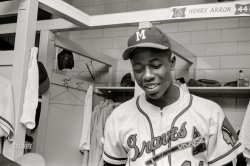
- Say Army: 1940
- ... 9, 1942, Kermit married Juliette Wilson Bennett of Atlanta. They had a daughter, Brenda Dale, and a son, Randy.
In September ... Posted by Dave - 08/09/2012 - 1:19pm -
![Say Army: 1940 Washington, D.C., June 1940. "New recruits join up. Kermit Kuhn, 21 years old, of Bayard, West Virginia, being examined by Army doctor Major Seth Gayle Jr." Harris & Ewing Collection glass negative. View full size.
SuspendersNote to vintage clothing enthusiasts: His trousers have buttons for suspenders, but he's wearing clip ons. Clip ons were definitely in use back in the day.
Wow!That would mean he was born in 1919 - and the same age as my parents! Hard to imagine my parents that young!
1-AGREETINGS!
Report for immediate induction into the armed forces of the United States of America!
Two years latermy father would lie about his age to fight in this war.
I salute you Pvt Kuhn, and all others that gave their lives in this war. You did what you had to do.
SadMy heart just broke a little. All the fine young men we've lost to wars.
The greatest generation-We're losing a huge number of them now per day, and heroes such as Kermit never had the pleasure of growing old beside their loved ones. It's good to see their bright, optimistic young faces and remember the sacrifices all of them made to preserve our basic American freedoms, now by many taken for granted.
CasualtyAlas, Kermit did not survive the war. He died 27 February 1945, and is buried in the Netherlands American Cemetery and Memorial.
1919-1945
Kermit Dale Kuhn was born August 22, 1919, at Bayard, West Virginia, the third of six children born to Walter and Margaret Kitzmiller Kuhn.
Kermit attended Bayard High School, where he played basketball and baseball. A star athlete, he was captain of the basketball and baseball teams and won the Bayard High School Athletic Award for his sportsmanship and athletic ability. Kermit was high point man in the basketball tournament at the Parsons sectional for three years.
Private Kermit D. Kuhn entered the Army on June 21, 1940, and was trained Fort Benning and Camp Gordon in Georgia; Camp Howe, Texas; and Camp Claiborne, Louisiana. On December 9, 1942, Kermit married Juliette Wilson Bennett of Atlanta. They had a daughter, Brenda Dale, and a son, Randy.
In September 1944, Kermit went overseas and received further training in England after which he saw action in France, Holland, Belgium, and Germany. In January 1945, Kermit, a member of the 309th Engineer Combat Battalion, 84th Division, was awarded the Bronze Star for the heroic act of administering first aid while under enemy fire to ten men who would have died without receiving it. His sister Mary Scripp received word from the War Department that Private Kermit D. Kuhn was killed in action in Germany on February 27, 1945. Private Kuhn was buried in the American Cemetery in the Netherlands.
-- Kermit Dale Kuhn, West Virginia Division of Culture & History
No war yetJune 1940 - still a year and a half from Pearl Harbor. Kermit probably had no idea that he'd be heading to Europe when this photo was taken. Makes it even more poignant that he didn't survive the war.
[The war started in 1939. In June 1940, Germany had just invaded France and the Battle of Britain was only weeks away. Europe is exactly where he would expect to be sent. - Dave]
Side noteMy father was wounded Jan 11 1945 near Samree, Belgium. He was in the 84th, 335th regimen. He met my mother a month or so before he was wounded. She was from Heerlen, Limburg, NL. She and her brother took care of graves at Margraten until, she came to the US in 1951 when she married my father. Small world.
GrandfatherHe was my grandfather. I have his medic kit and flag. Thank you all for your comments.
(The Gallery, D.C., Harris + Ewing, Medicine, WW2)](https://www.shorpy.com/files/images/SHORPY_28835a.thumbnail.jpg)
- Motive Power: 1926
- ... passenger train service between New York, Washington, Atlanta and New Orleans."
Alexandria, Virginia, circa 1926. "Southern ... Posted by Dave - 05/21/2016 - 3:05pm -
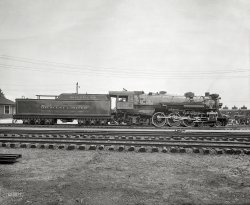
- Victory: 1943
- ... from the Bethlehem-Fairfields yards here.
Atlanta Daily World, May 24, 1943.
Race Captain at Helm of Douglass
... Posted by Dave - 09/22/2013 - 10:46pm -
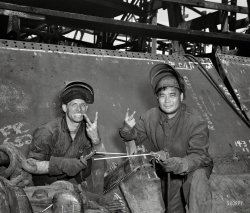
- The Ideal Brain Tonic
- ... ad for the Douglas, Thomas & Davison soda fountain in Atlanta, birthplace of Coke and home of the new Coca-Cola museum. [Credit: ... Posted by Dave - 07/30/2007 - 5:35pm -
![The Ideal Brain Tonic A very early use of Coca-Cola's now-familiar Spencerian script logo (at least the earliest example we could find in a newspaper archive of more than 64 million pages) was in this April 15, 1894, ad for the Douglas, Thomas & Davison soda fountain in Atlanta, birthplace of Coke and home of the new Coca-Cola museum. [Credit: NewspaperArchive.com]
(Very Old Ads, Coca-Cola)](https://www.shorpy.com/files/images/coca-cola_1894.thumbnail.jpg)
- Eight Till Noon: 1865
- ... indeed, St. Michael's Episcopal still stands. Unlike Atlanta and Columbia and hundreds of other towns and villages along the way of ... Posted by Dave - 07/31/2012 - 9:28pm -
![Eight Till Noon: 1865 1865. "Charleston, South Carolina. Meeting Street, near Broad; St. Michael's Church in middle distance. Photograph of the Federal Navy, and seaborne expeditions against the Atlantic Coast of the Confederacy." View full size. Left half of a wet-collodion glass-plate stereograph. Juniper Gallery fine-art print.
Tower in the distanceThe next tower down the street (with scaffolding): is that another church bell tower? Do any of these beautiful buildings still stand?
Interesting.Interesting. The trees lining the street might have served as convenient ties as well as shade for the horses.
Shorpy is one of my favorite sites: a wonderful window into the past.
The treesI'm used to urban trees being planted in gaps in the sidewalk. Interesting that in this shot the sidewalk is paved but the road isn't, and the trees are in the road.
Still Standing?Yes indeed, St. Michael's Episcopal still stands. Unlike Atlanta and Columbia and hundreds of other towns and villages along the way of Sherman's march to the sea, Charleston was largely bypassed by the general's hordes. The battery area of Charleston dates to well before the War between the States -- quite a bit is pre-Revolutionary. Well worth a visit if you enjoy old architecture, great food and friendly, welcoming people.
CharlestonThis looks like it the opposite end of the street of "After the Bombardment."
Blurred man on sidewalkNotice the guy walking along the sidewalk on the left. He is blurred from his movement. He takes about four steps. There's also someone exiting the dark space between the columns on the right -- also blurred. And of course there's the people seen off in the distance.
[On the right, I think that's a lady with a hat going into the building. - Dave]
Street TreesThat's interesting that trees are planted right in the street, not enclosed like trees would be today.
Re: Tower in the distanceI think the tower in the distance is the Circular Church, which was restored. It and the bigger church in this picture are still standing today. Charleston still looks quite like this picture... just with cars on the streets, and no trees planted in the road.
[Yes, the tower with the scaffold is the Circular Congregational Church, which was being rebuilt after a fire in 1861. - Dave]
+145The view is looking north from just below Broad. The beautiful house on the right remains as does one on the left. Below is the same view from May of 2010.
(The Gallery, Charleston, Civil War)](https://www.shorpy.com/files/images/SHORPY_02413u.thumbnail.jpg)
- Peachtree Street: 1957
- ... We are looking north on Peachtree Street in downtown Atlanta on August 30, 1957. On the left is one of Atlanta's two principal department stores, Davidson's; also, the Roxy Theater ... Posted by prrvet - 03/21/2018 - 4:53pm -
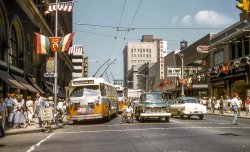
- A Dark Chapter, in Color
- ... and brick sidings; North facing I suspect. Having lived in Atlanta for many years, I think the dirt streets might be a touch more orange ... Posted by Fredric Falcon - 09/20/2011 - 1:22pm -
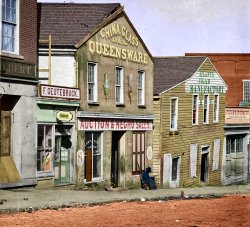
- The Case of the Dented Dodge
- ... but there are still some of them in use here in the Atlanta area.
[I believe the hanging "X" signs relate to the rail tracks ... Posted by Dave - 01/08/2016 - 9:01pm -
![The Case of the Dented Dodge Oakland circa 1953 and another vehicular misadventure, this time starring the bike that couldn't quite dodge a Dodge. Cameos by two Cadillacs. View full size.
Lane MarkersI don't know exactly how those old lane markers (X) are operated, but there are still some of them in use here in the Atlanta area.
[I believe the hanging "X" signs relate to the rail tracks that appear to be running along the cross street. -tterrace]
19 cent hamburgersThat seems rather high for 1953, especially since they didn't have to go far to get the meat.
X for a CrosswalkI remember seeing those "X" signs used to indicate to drivers that a pedestrian crosswalk was located below.
19¢ hamburgers!Those 19 cent hamburgers would be nice in this day of low wages and tight budgets.
The 19¢ hamburger story continuesIt was probably about this time that the Hi-Fi Drive-In on U.S. 101 in downtown Petaluma, California put up their "19¢ Hamburgers" sign, the "19¢" in huge, neon-and-bulbs-illuminated letters. It was my first lesson in the realities of economics when at some point in the 1960s the "Hamburgers" under the "19¢" was changed to "Fries."
X for Ped Xing?I remember them as markers for pedestrian crossings. We appear to be at the intersection of Telegraph and Grand, looking down Telegraph with Grand as the cross street. The Key System ran down Telegraph, no tracks on Grand:
http://djjr-courses.wikidot.com/soc128:project13-key-system
Cancel Previous TransmissionRailroad crossing is plausible, you can see the overhead trolley wires as well as the tracks. Now I'm confused as to which way we're looking. It's only been fifty plus years since I was at that intersection.
MEATS MEATSYou just don't see signs like that anymore.
Scene todayThanks to the Google Street View Time Machine:
You Have Reached Your DestinationX marks the spot!
(The Gallery, Bicycles, Cars, Trucks, Buses, News Photo Archive, Signal 30)](https://www.shorpy.com/files/images/SHORPY-844.thumbnail.jpg)
- Let's Go Play In Traffic: 1957
- ... taken by me, William D. Volkmer, on August 30, 1957, on Atlanta's Peachtree Street in the theater district during a Shriners ... realized it was an electric coach (something I never knew Atlanta had) and not a bus, so there would be no exhaust pipe. Instead it seems ... Posted by prrvet - 03/16/2018 - 3:38pm -
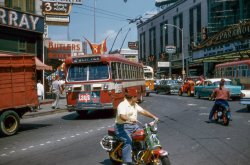
- Banana Boat: 1903
- ... to judge events in New Orleans by the standards of, say, Atlanta or Birmingham, especially on the basis of a vignette. Unloading a ... Posted by Dave - 07/19/2012 - 4:39pm -
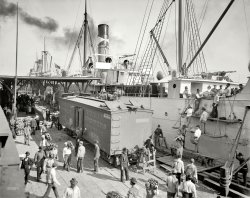
- Five Cents' Worth: 1941
- ... Anyone else have an opinion? Cornbread and cabbage were Atlanta School System staples well into the 1960s, as I have reason to ... Posted by Dave - 11/28/2019 - 4:53pm -

- Chattanooga Depot: 1864
- ... year, when Chattanooga was the base for Sherman's Atlanta campaign." Wet plate glass negative, half of stereo pair, photographer ... Posted by Dave - 10/16/2008 - 8:04am -
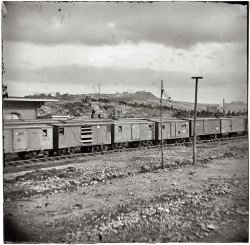
- Mount Airy: 1938
- ... point of which was to be the escape from the burning of Atlanta via flying carpet.
Re: Epic that never was. Shh, not so loud, ... Posted by Dave - 08/30/2012 - 11:07am -
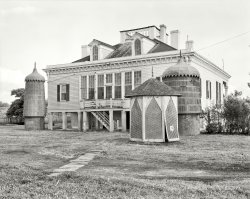
- Parcel Post: 1914
- ... Whites and Wagenhals had been dispersed as follows:
Atlanta, Ga., 2 Whites; Baltimore, 3 Whites; Brooklyn, 3 Whites, Buffalo, 2 ... Posted by Dave - 08/09/2012 - 6:47pm -
![Parcel Post: 1914 Washington, D.C., 1914. "Post Office Department -- parcel post." A scene outside the post office on Pennsylvania Avenue in its final year of operations before it moved and the building became known as the Old Post Office. View full size.
U-shaped bracketsNice truck! I'd love to have it in that condition right now. My question is, what are those big u-shaped brackets in front of the radiator? Maybe for headlights? If so, what are the smaller lights mounted on either side of the dashboard? Oh, and of course, what make and year is the truck?
[The small lamps are running or parking lights. - Dave]
In the DarkWhere are the headlights?
Parcel Post serviceThis was the year after the Post Office Department began domestic Parcel Post service. Originally, a series of special stamps was issued.
"Neither rain, nor sleet, nor snow"Only darkness will stop them from their appointed rounds. Notice the headlights seem to be missing from the bracket holders.
Dark of Night"Neither snow nor rain nor heat nor gloom of night stays these couriers from the swift completion of their appointed rounds". I think the "gloom of night" might stay this one.
Righty?Right hand drive? Was that common in those days?
[Still the case for mail delivery vehicles. -tterrace]
KisselKar truckThis is a 1913 KisselKar truck, made by the Kissel Motor Car Company of Hartford, Wisconsin.
In July 1913, to prepare for the domestic Parcel Post delivery service that tterrace mentioned, the United States Post Office Department's Committee of Award accepted a bid by the White Company for 20 vehicles rated at 3/4 ton capacity. They cost $2,060 each and had to be equipped with either pneumatic or cushion tires, depending on what the Post Office decided. The Post Office also ordered 21 Wagenhals Motor Car Company three-wheeled vehicles that had 800 pounds capacity. Powered by a 20 hp water-cooled four-cylinder engine, they cost $625 each (visually similar to the less expensive electric version below). Located in Detroit, the Wagenhals Motor Car Company would reorganize just a month later as simply the Wagenhals Motor Company. Both the Whites and the Wagenhals had to be delivered to Cleveland, Ohio within sixty days.
A year later the Post Office was advertising for bids for spare parts for these vehicles, which included: "Transmission and cup grease, horn bulbs, cylinder and heavy oil, blow out and tube patches, pressure gauges, cushion and pneumatic tires, inner tubes, tire tape, valve parts and tools, vulcanizing rubber, etc."
The winner of the bid had to supply each individual post office named in the contract, and the parts just couldn't be dumped in front—the bid proposal stipulated that "All the supplies must be delivered at and within the doors of the post offices."
The bid proposal noted that the Whites and Wagenhals had been dispersed as follows:
Atlanta, Ga., 2 Whites; Baltimore, 3 Whites; Brooklyn, 3 Whites, Buffalo, 2 Whites; Columbia, S. C, 1 Wagenhals; Columbus, O., 2 Wagenhals; Detroit, 2 Wagenhals; Louisville, 2 Whites; Memphis, 3 Wagenhals; Minneapolis, 4 Whites; Nashville, 3 Wagenhals; Norfolk, Va., 2 Wagenhals; Philadelphia, 6 Whites, Richmond, Va., 2 Wagenhals.
Two possibilitiesThe headlamps are, being actual brass lanterns, probably on a bench getting cleaned and filled (or re-carboned). No reason to rattle around with them on the truck all day long. Or maybe they just don't drive this truck at night.
[Many if most trucks of the era didn't have headlights. The brass fixture illustrated below is an acetylene gas lamp. - Dave]
Believe it or notIn the early years of the auto business the lights were optional. I suppose driving after dark was pretty dicey even with the improved illumination provided by acetylene. For a business that normally operated during daylight hours I imagine that the expense and hassle of the lights was not worthwhile.
Speedy Delivery
Washington Post, March 2, 1913.
Five Kissel cars, bought by the government for parcel post in the city of Washington, D.C., have been placed in service after a thorough inspection by Postmaster General Hitchcock and Postmaster Merritt, of Washington. They are 30-horsepower wagons of 1,500 pounds carrying capacity, and are painted a brilliant red. On its initial run one of the cars made 152 stops between 8:30 a.m. and 12 noon.
Brilliant red was not what I was picturing for this vehicle when first looking at the photo. I had thought a more institutional green or dark blue, but with enough squinting I can begin to imagine red, perhaps a color chosen to express speed and priority.
(The Gallery, Cars, Trucks, Buses, D.C., Harris + Ewing)](https://www.shorpy.com/files/images/SHORPY_03914a_2.thumbnail.jpg)
- Family Porchrait: 1939
- ... live in an electrified house until she was 20 and moved to Atlanta. They are dumb-founded. Rural electrification was a great thing. The ... Posted by Dave - 06/24/2012 - 12:53pm -
![Family Porchrait: 1939 January 1939. Chicot Farms, Arkansas. "Husband and wife on porch of farm house." Photo by Russell Lee, Farm Security Administration. View full size.
New Home OwnershipI can feel the pride they have showing off their new home; all white and pretty. Are those some kind of manufacturer stickers on the window panes? You know, like Minnie Pearl's hat with price tag still attached.
Ma & Pa KettleAnd from the looks of that ax, Joan Crawford is probably lurking somewhere nearby.
Christmas lights?Those "stickers" in the window look like Christmas lights (which would be somewhat appropriate since it's January). It's hard to tell if they're really lights or just stickers.
Okay, I'm going with Christmas light stickers.
Just mucking aroundBesides fishing, you'd need the boots when doing the chores such as feeding the hogs or mucking out the stable. You wouldn't want to be stepping in that stuff with regular shoes. Also, Ms Hen might not be ready to meet her demise. On family farms, it would be the poorest layers who'd meet their doom first.
Uniroyal, Red Ball or LaCrosse?No signs of fishing equipment in the scene, so I wonder - why the hip boots?
Ms. Hen in the left background may be the guest of honor for that chopping block.
[I truly love old farm scenes.]
ElectricityIf these folks didn't have power for a radio, they probably didn't have power for Christmas lights.
Chopping blockBlock could most certainly be used on ms hen's neck, however, the block was most likely for chopping firewood.
A hatchet for the hen, an ax for the wood.
Hip BootsI have no idea why he's wearing those boots, but to SJBill's comment about fishing, it seems that Chicot Farms was/is located on Chicot Lake.
Boots on the groundBoot are a must have on a farm. Animal muck everywhere. I wore mine all the time. No worries and when you are done you can spray them with the hose before you take them off.
I tell young friends that my Mother didn't live in an electrified house until she was 20 and moved to Atlanta. They are dumb-founded. Rural electrification was a great thing. The electric company's would never have done it. To few customers to justify the lines.
Also, great dog!
Dawg on the left"I smell a cat around here somewhere..."
(The Gallery, Cats, Dogs, Russell Lee)](https://www.shorpy.com/files/images/SHORPY_8a24942a.thumbnail.jpg)
- The Help: 1939
- May 1939. "Negro domestic servant. Atlanta, Georgia." Medium format negative by Marion Post Wolcott for the Farm ... Administration. View full size.
(The Gallery, Atlanta, Kids, Kitchens etc., M.P. Wolcott) ... Posted by Dave - 04/06/2019 - 5:23pm -
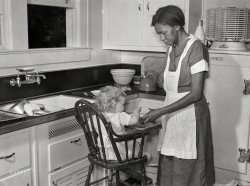
- Showtime in Chicago: 1941
- ... What, they were going to clip out the burning of Atlanta because the show ran long?? Oy gevalt!
Late Arrivals I hope ... Posted by Dave - 02/11/2019 - 4:09pm -
![Showtime in Chicago: 1941 April 1941. "The movies are popular in the Negro section of Chicago. Regal Theater and Savoy Ballroom in the Southside neighborhood." Medium format negative by Russell Lee for the Farm Security Administration. View full size.
Looked the same in 1961when I was producing a series of Chicago jazz sessions for Riverside Records. I took this photo then—notice Sam Cooke and The Drifters were on the bill.
This ain't a rehearsalI know it's been said before, but I love the way people used to dress up to go out. I still dress up when I go out. You live one time; dressing up is a nod to the uniqueness of every day.
[As well as, in this case, Easter Sunday. - Dave]
All the more reason to resurrect the custom of dressing up to go out.
The first car is a 1940 Mercury. I bought one in 1968, and restored it by 1972. I used it for about 40 years, and then gifted it to a young friend who will take care of it for many years to come.
UneditedI find it sorta remarkable that on the coming attractions, the Regal found it necessary to say they’re showing GWTW with “Nothing Cut but the Price”. What, they were going to clip out the burning of Atlanta because the show ran long?? Oy gevalt!
Late ArrivalsI hope these filmgoers got a break at the box office in April of 1941. Both "The Philadelphia Story" and "Life With Henry" were released and had already been shown in movie houses in 1940.
Previously on Shorpy ...We've been to the Savoy for roller skating a couple of times.
The Coasters: 1941
Saturday Night: 1941
I hear a MeadowlarkIn addition to movies and roller skating, the Savoy also had basketball exhibitions by the Savoy Big Five, who later changed their name to the Harlem Globetrotters.
Basie at the SavoyIt looks as if Count Basie was playing the Savoy ... can you imagine?
ObservantI'm fascinated that the ones who noticed Mr. Lee are all children. So many of them are looking directly at the camera.
Also, The Philadelphia Story is worthy of many, many viewings.
(The Gallery, Cars, Trucks, Buses, Chicago, Movies, Russell Lee)](https://www.shorpy.com/files/images/SHORPY-8c00898a.thumbnail.jpg)
- West Hotel: 1905
- ... or less stopped after the "fireproof" Winecoff Hotel in Atlanta burned on December 7, 1946, killing 119.
(The Gallery, DPC, ... Posted by Dave - 08/13/2012 - 6:00pm -
![West Hotel: 1905 Minneapolis, Minnesota, circa 1905. "West Hotel." Busy both architecturally and commercially. 8x10 inch glass negative, Detroit Publishing Co. View full size.
Mass transit then and nowCould the young couple standing under the arched overhang be waiting for Jesse Ventura's light rail?
Prof. HillMight have seen that Billard sign as a call to arms to save the city from itself.
West Hotel - 1927Here's a picture of the hotel in 1927, looking a bit darker than it is in the above photograph. Most likely due to lighting.
[It would also be due to soot. Masonry buildings turn black after years of exposure to coal smoke. - Dave]
Things Go BetterFred C Weinhold had himself a great spot for his Drug Store, right out on the street in front of the West Hotel and more than likely with an entrance to the shop from inside the hotel itself. He was also supported by the Coca-Cola Company, in their infinite advertising wisdom, with a sign right at the entrance to the store.
Before the blazeA 1900 tourist guide described the West as fireproof, but January 10, 1906, showed otherwise. That morning, a fire that began in the bottom of an elevator shaft spread upward, generating toxic smoke, and eventually flames that ran through the top floors. Ten died, several by leaping or falling to their deaths from those many ledges. But the structure remained intact, and within months the hotel was again hosting major national conventions.
The loss of this beauty can't be blamed on urban renewal. It was demolished in 1940, at the choice of its owner, Philadelphia Fidelity-Philadelphia Trust Co.
FireproofThe term "fireproof" was originally used by insurance companies simply to denote that a building was of masonry/steel frame construction, and the shell of the building could therefore not burn down. Hotel owners were quick to seize upon the term and use it in their advertising, but the practice more or less stopped after the "fireproof" Winecoff Hotel in Atlanta burned on December 7, 1946, killing 119.
(The Gallery, DPC, Minneapolis-St. Paul, Streetcars)](https://www.shorpy.com/files/images/4a12297a.thumbnail.jpg)
- Man of Letter: 1904
- ... the Elkridge of Maryland, the Piedmont Driving of Atlanta and the Metropolitan of Washington.
... Posted by Dave - 01/23/2020 - 9:31am -
